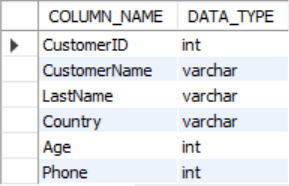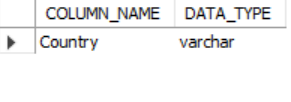
|
|
In SQL, the types of columns in a database table play a fundamental role in data management and query execution. Each column is designed to store specific types of data, such as numbers, text, dates, or binary data. Understanding these column types is essential for effective database design, query optimization, and ensuring data integrity. In this article, we cover retrieving column types in SQL using three methods: SQL’s Information Schema, the DESCRIBE statement, and Database GUI Tools. Each method offers insights into column types, aiding effective data management. Output includes detailed information about column data types, facilitating database schema understanding and query optimization. How to Get the Type of Columns in SQLIn databases, each column stores a particular kind of data. A column can hold numbers, words, dates, or other data formats. Understanding column types is crucial for managing and finding data in SQL. This knowledge helps design databases properly. It ensures accuracy and efficiency throughout data storage and use. This article explains three ways to find column types in SQL. These methods follow standard rules or work for specific databases like MySQL, SQL Server, or PostgreSQL. Database experts can use these methods to work with SQL accurately and confidently.
1. Using SQL’s Information SchemaThe Information Schema gives details about the database. For example, it shows information about tables, columns, and data types. You can check the INFORMATION_SCHEMA.COLUMNS view to learn about columns. This view shows you what columns exist in each table. Syntax:
Replace ‘YourTableName‘ with the name of the table whose column types you want to retrieve. Created Table
Now, if we want to see the Type of columns. SELECT COLUMN_NAME, DATA_TYPE Output:
Also, you can find for particular column by adding COLUMN_NAME=’NameOfColumn’; Example: Retrieving Column Type Using SQL’s Information SchemaSELECT COLUMN_NAME, DATA_TYPE Output:
Explanation: This query retrieves the column name and data type from the “customer” table where the column name is “Country” using SQL’s Information Schema. 2. Using the DESCRIBE statementThe DESCRIBE statement helps you know about columns in a database table. We use it with the table name. MySQL gives details for each column. It shows the column name, data type, if the column can be empty, and other things. This makes it easy to understand the table without complex actions. Syntax:
Replace ‘TableName‘ with the name of the table you wish to describe. Example: DESCRIBE statementDESCRIBE Customer;
Create a table named “Customer“, you can use a simple code to check its type. The code is easy to understand and will show you what kind of table “Customer” is.  DESCRIBE keyword Explanation: The output displays the structure of the “Customer” table, including the names of its columns, their corresponding data types, and any additional attributes such as nullability or default values. 3. Using Database GUI ToolsDatabase GUI Tools are graphical interfaces that provide a user-friendly way to interact with databases. They offer features like visual query building, data manipulation, and schema exploration. Also, GUI present in SQL app like MYSQL, if you go to navigator-> select the database(where your table is present) It will give you all information about column types.
Explanation: Choose the method that best fits your needs and the specific DBMS you’re using. These methods will allow you to retrieve the types of columns in SQL tables effectively. ConclusionIn conclusion, understanding column types in SQL databases is fundamental for effective data management. Through methods like SQL’s Information Schema, the DESCRIBE statement, and Database GUI Tools, users can swiftly identify column data types. This knowledge enhances database querying, ensures data integrity, and supports informed decision-making in various applications and industries. |
Reffered: https://www.geeksforgeeks.org
| Databases |
Type: | Geek |
Category: | Coding |
Sub Category: | Tutorial |
Uploaded by: | Admin |
Views: | 11 |


.png)